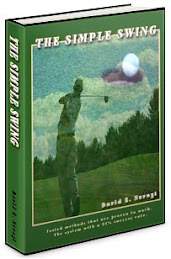When you have been involved in the golfing industry for 20 years you really do hear some interesting stories regarding golf equipment theories. Most of them are exactly that, just a theory, a wives tale or someone's imagination producing an idea that will revolutionize their golf game to be better than Tiger Woods.
Here are 5 of the most common golfing equipment myths that I get asked about and a quick explanation on the truth behind the myth.
1 - Golf Ball Bounce Test
You will see golfers around the world testing how high a golf ball will bounce to determine what type of golf ball to buy or to use for their round. Gravity's pull on a golf ball while being bounced on a hard surface cannot be compared to being hit by a clubhead traveling at high speed that can produce anywhere up to 1000kg or more of compression. The amount of compression that gravity produces on a golf ball will not be nearly enough to take into consideration ball construction attributes, such as, two-piece versus three-piece, wound versus solid cores, number of layers and materials.
Golf Ball Bounce Test = Not True!
The only way to find the best ball for your game is to experiment, ask your local pro for some advice or find a launch monitor and experiment with a variety of golf balls until you discover the correct one for your swing and club.
2 - Putters Sweet Spot Is The Aiming Line
Close to being true, but not 100% of the time. Putters like all golf clubs are produced in mass numbers and therefore there is going to be small differences. The common differences between putters is the aiming lines on top of your putter not aligning with the putters sweet spot.Putters
Sweet Spot Is The Aiming Line = Not True!
To find your putters sweet spot, simply hold the top of your putter grip in two fingers and tap the putters face with a sharp object like a pencil. The putter face will twist when you are not tapping the sweet spot and swing straight backwards and forwards when you have struck the sweet spot!
3 - Only Grooves Create Backspin
Backspin is created by the ball being compressed and embedded on the clubface. The amount of backspin will vary depending on many factors, such as angle of clubface angle/loft, the more clubface angle the greater backspin that is created.
Only Grooves Create Backspin = Not True!
So what is the roll of groves on a golf club? To remove debris from between the golf ball and the clubface at impact so the ball can receive maximum compression and stay embedded on the clubface
4 - Topspin Equals Ball Roll
If we hit a ball with topspin it would go straight into the ground! To get a golf ball airborne and to stay in the air it needs to be hit with backspin. To improve length from the tee and increase roll you need to minimise backspin on an optimal launch angle, launch monitors are being used to successfully measure and pinpoint the optimal angle and spin rates.
Topspin Equals Ball Roll = Not True!
5 - 5 & 7 Woods Are For Hackers
5 & 7 woods or other utility woods are not just for hackers, you could actually label golfers that use these woods/clubs as smarter golfers. Most golfers cannot play long irons very well when in perfect conditions, let alone hold a green or play them from some light or even deep rough. In fact most golfers find that their long irons, such as a 3 and 4 iron go the same distance, this is because they cannot create enough backspin to keep the ball in the air. If they had a 5 wood, 7 wood or other utility club they would find that with their higher ball flight and softer landing would definitely make these shots easier and as they create more backspin with slower swing speeds you will be able to achieve different distances with them.
5 & 7 Woods Are For Hackers = Not True!
Hope I have answered some golfing myths for you and you can enjoy your next round of golf knowing that you are a wiser golfer!. Hope to see you on a Gold Coast golf course soon.
Article by Bradley Davis
Article Source: http://EzineArticles.com/?expert=Bradley_J_Davis
Saturday, 5 December 2009
Subscribe to:
Post Comments (Atom)









No comments:
Post a Comment